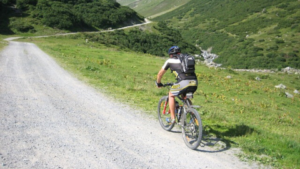Biking is one of the most enjoyable activities out there. You can go outside and get a fantastic and quick workout. There are, however, several disadvantages to biking. Chafing is one of the most unpleasant disadvantages of it.
Fortunately, there are several things you can apply to avoid chafing. You might think only ointments and creams are solutions, but several other major factors can also help avoid chafing, which we will discuss here.
This article is for anyone who wants to know what chafing is, what factors contribute to it, and how to stop it from occurring and contains all the required information.
A step-by-step guide to preventing chafing while biking

Along with the numerous ways to chafe one’s skin, there are also several ways to treat the condition. Those of you who have experienced chafing can get relief by following the measures outlined in this article.
You won’t ever have to worry about having to cope with the agonizing burning sensation caused by your skin being overly sensitive ever again.
Here are the solutions:
Step 1: Adjust Saddle fit and Seat height properly
Saddle Fit
You’ve probably heard about saddle sores. Chafing is just a different term for the same thing. In this way, saddles play a significant role in developing saddle sores. People with chafing issues may find the bike seat an unpleasant place to ride. A saddle with internal padding is a must for riders of all types of cycles, from racers to century riders.
Verify that the saddle’s size fits your girth. If the breadth of the saddle is about the same as your waist, then it is the right size for you.
In contrast, most cushioning is created using foam, which might deflate and lose its initial shape if not replaced regularly. If you regularly ride in the wet, you should switch out your pads as needed.
Seat Height
When it comes to chafing, seat height is another factor that might make a significant difference. If the seat is excessively high, the hips will sway back and forth, causing chafing in the space between the inner thighs.
Again, you risk encountering additional friction if your seat is positioned too low. This will also throw off your body position. You will need to adjust the seat height perfectly according to your needs.
Step 2: Invest in a Bike fit
A cyclist’s best buddy is a pair of shorts designed for cycling. Having chamois padding in the crotch area of your cycling shorts will help you avoid chafing and other discomforts, especially at high speeds.
Wide-legged bike shorts can prevent the common but potentially dangerous occurrence of a cyclist’s legs becoming entangled with one another.
Just to be safe, you should get to know your bike well and make sure it suits your needs. Verify the seat height, handlebar angle, the tilt of the saddle, and so on.
You will undoubtedly experience discomfort without a proper bike fit once you get home.
Step 3: Wear the Correct Shorts
What we mean by “correct shorts’’, is not the length of the shorts, but rather we are referring to the material and cut of the garment the shorts are made from. For this purpose, you can purchase bicycle shorts with the appropriate padding.
The surface tension on your skin is not caused by the compression that is caused by the shorts because they are built with elastic fabric. In terms of fitting, we recommend choosing a pair of slightly loose shorts rather than one that is close-fitting.
Step 4: Change your riding Shorts More Often
The appropriate shorts are important, but so is making sure you swap them out regularly. This holds truer if you intend to ride for multiple consecutive days.
When you return from a bike ride, you should immediately take off your shorts and take a hot shower. Using this method will aid in removing harmful bacteria that can lead to chafing, skin irritation, and even rashes.
Furthermore, you should rapidly clean your shorts after cycling. If your shorts’ pH balance has been disturbed, this should help get it back to normal.
Step 5: Use Chamois Cream
Chamois creams are usually a mixture of aloe vera, oil, shea butter, and various soothing ingredients
Using chamois creams is one of the simplest solutions you can apply. It will reduce friction in concerned areas, namely the nether regions. Don’t be miserly; it’s better to use too much than too little.
And sample several before settling on a favorite. You may get chamois cream formulated for female use, and some of these formulations even include antimicrobial components.
Step 6: Purchase New and Quality Chamois

The cushioning in chamois wears down with time, and this will cause the chamois to shift back and forth as you cycle. This will increase the amount of friction, which will likely result in chafing.
When your chamois pad is no longer thick, or your stretchy spandex isn’t as elastic as earlier, you should probably replace your chamois pad and get a new one.
It is also essential to keep in mind that not every chamois is constructed in the same manner. It’s a good idea to try on a few different pairs of chamois so you can determine which ones are the most comfortable for you.
Similar to bike saddles, no singular chamois is universally regarded as the best option.
Step 7: Investing in Anti-Chafing Products
Investing in an anti-chafing remedy is one of the finest ways to protect against rubbing discomfort. Balms, creams, sticks, and salves are the most common forms this takes.
Be sure to use an anti-chaffing product designed with motorcyclists in mind. Try to find products infused with cocoa butter and oil, both natural substances, that are softer on the skin and worth looking for.
Last but not least, when selecting a solution, make sure it is portable and can be easily reapplied during lengthy bike trips by placing it in a pocket or pouch.
What is Chafing, and How Does It Occurant While Biking?
For those who don’t know, chafing is a form of skin irritation that occurs when one portion of your skin rubs against another area of your skin. It can also happen if something brushes against your skin. The condition is caused by repeated friction, but moisture can intensify it. Sweaty chamois, tight or loose cycling shorts, and an inadequate saddle fit can cause bike chafing.
Conclusion
These are the main reasons why chafing occurs in the first place. It is a very common disturbance to bikers and can be extremely annoying. With the solutions provided, however, you should be able to treat chamois effectively and without any further discomfort.
As usual, adjust saddle fit and seat height and wear proper bike fit with a padded chamois to avoid chafing.

I am Ryan Ford, a mountain biking enthusiast who loves to explore the outdoors. I also like to go on adventures with friends and anything else that involves being outside. I love my bike because it gets me out of the house and gives me an opportunity to enjoy nature.
